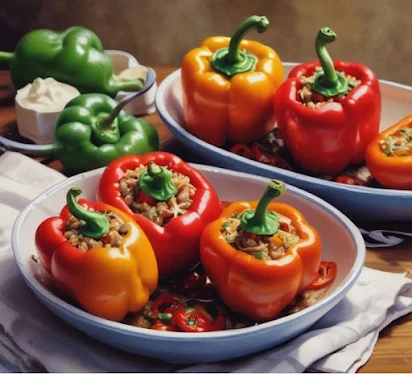The Magic of Stuffed Bell Peppers
Bell peppers - Magicstudios
Introduction to Stuffed Bell Peppers
Ingredients
and Benefits of stuffed Bell Papers
1. Bell Peppers:
Benefits: Rich in vitamin C for immunity, antioxidants for fighting free
radicals, and fiber for healthy digestion.
Alternative: Zucchini boats or hollowed-out tomatoes for a twist on the
classic.
2. Rice:
Benefits: A source of carbohydrates for energy and fiber if whole grain
is used.
Alternative: Quinoa for extra protein and nutrients, or cauliflower rice
for a low-carb option.
3. Ground Meat (beef, turkey, or
chicken):
Benefits: Packed with protein for muscle maintenance and iron for
energy.
Alternative: Lentils or mushrooms for a vegetarian alternative with a
meaty texture.
4. Cheese:
Benefits: Calcium for strong bones and a creamy flavor enhancer.
Alternative: Nutritional yeast for a vegan, cheesy taste, or skip it for
a lighter dish.
5. Spices (like paprika or oregano):
Benefits: Add flavor while boosting metabolism and offering anti-inflammatory
properties.
Alternative: Fresh herbs like cilantro or basil for a milder, aromatic
touch.
Did you know?
In the 18th century, bell peppers were nicknamed "capsicum apples"
and were considered exotic treasures. Imagine trying to stuff an apple instead—though
it’s not as far-fetched as it sounds. Next time, give it a shot; you might
invent the next culinary craze!
Instructions (with a Smile)
1. Preheat
oven to 375°F (190°C): This step is crucial unless you want to serve
"raw-and-ready" stuffed peppers. Give your oven a head start—it likes
to feel useful too.
2. Cut
the tops off bell peppers and remove seeds: Think of this as giving
the peppers a trendy new haircut. Scoop out the insides carefully unless you
want a surprise crunch of rogue seeds later.
3. In
a skillet, cook ground turkey with diced onion and garlic until browned:
This is where the magic happens. Sauté like you’re auditioning for a cooking
show, but try not to toss onions out of the skillet—it’s not that kind
of show.
4. Add
cooked brown rice, black beans, corn, diced tomatoes, and spices to the
skillet. Mix well: This step is basically a party in your skillet.
Stir it up like a DJ spinning the hottest hits at your stovetop.
5. Stuff
peppers with the mixture and place them in a baking dish: Be generous
with the stuffing—it’s the star of the show! But don’t overdo it, unless you
want peppers bursting with personality (and filling).
6. Cover
with foil and bake for 30-35 minutes, until peppers are tender: Let
the oven work its magic while you enjoy 30 minutes of uninterrupted Instagram
scrolling or pretending you cleaned the kitchen.
Instructions (with a Smile)
1. Preheat
oven to 375°F (190°C): This step is non-negotiable unless you're
aiming for "chilly peppers." Give the oven its moment to shine—it’s
the quiet hero of the kitchen.
2. Cut
the tops off bell peppers and remove seeds: Think of this as giving
your peppers a stylish hat makeover. Be careful, though; no one likes surprise
seeds crashing the dinner party.
3. In
a skillet, cook ground turkey with diced onion and garlic until browned:
Channel your inner chef here—bonus points for a dramatic stir and a sprinkle of
flair. Just don’t flip the turkey onto the floor.
4. Add
cooked brown rice, black beans, corn, diced tomatoes, and spices to the
skillet. Mix well: Picture your skillet as a dance floor, and these
ingredients are throwing the party of the year. Stir until everyone’s having a
good time.
5. Stuff
peppers with the mixture and place them in a baking dish: Be generous,
but not too generous—you want the stuffing inside the peppers, not
sprawling across the dish like a messy roommate.
6. Cover
with foil and bake for 30-35 minutes, until peppers are tender: Now
let the oven take over while you bask in the glory of a job well done. Or at
least until the timer beeps.
Why Seniors Love Stuffed Bell Peppers
Stuffed bell peppers aren’t just tasty; they’re a senior-friendly superfood!
Packed with vitamin C, they boost immune health and keep skin glowing, while
their fiber helps digestion stay on track—an essential perk as we age. The
soft, tender texture makes them a joy to eat, even for those with dental
challenges, and the versatile filling options can easily fit dietary needs like
low sodium or high protein.
The finished dish? Vibrant, flavorful, and nourishing—like a hug on a plate.
And unlike real hugs, this one won’t include awkward pats on the back or
unsolicited advice about your life choices. Enjoy every bite!
Cultural Names of Bell
Peppers: From Pili Pili Hoho to Paprika
- East Africa: Pili Pili
Hoho (Swahili)
- United States/Canada: Bell
Peppers
- United Kingdom/Ireland:
Peppers
- India: Capsicum
- Australia/New Zealand:
Capsicum
- South Africa:
Green/Red/Yellow Peppers
- Germany: Paprika
- France: Poivron
- Spain: Pimiento
- Italy: Peperone
- Portugal/Brazil: Pimentão
- Netherlands/Belgium:
Paprika
- Japan: ピーマン
(Pīman)
- China: 甜椒
(Tiánjiāo) or 青椒 (Qīngjiāo, for green peppers)
- Korea: 피망
(Pimang)
- Russia: Перец (Perets)
- Mexico/Latin America:
Pimiento Morrón
- Turkey: Dolmalık Biber
- Greece: Πιπεριά (Piperia)
- Philippines: Lada or Bell
Pepper
The terminology often depends on the pepper's color, variety, and local
culinary use. For example, in some countries, the word "paprika"
refers to the spice made from bell peppers.




Comments
Post a Comment
Your comments are very important to this blog. Feel very free to make your opinion known. We will respect it.